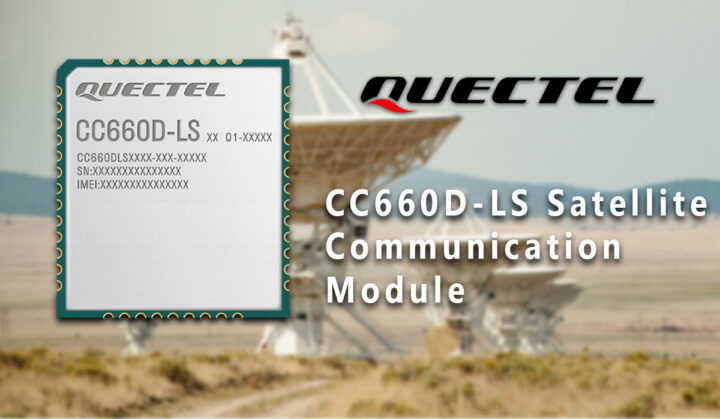Quectel recently announced the launch of the Quectel CC660D-LS IoT-NTN module, created in partnership with Skylo. Designed for two-way IoT (Internet of Things) applications this model supports the latest 3GPP Release 17 standards for IoT over non-terrestrial networks (NTN). Additionally, It can operate on L-band (1 to 2 GHz), and S-band (2 to 4 GHz) frequencies, making it ideal for asset tracking, fleet management, and agricultural and maritime uses.
Last year, we wrote about Qualcomm 212S and 9205S satellite modems which were also developed in collaboration with Skylo.
Quectel CC660D-LS IoT-NTN Satellite Module Specifications:
- Module Type – NTN satellite communication module
- Compliance – Supports 3GPP Rel-17 IoT-NTN
- Frequency Bands – Operates on L-band (B255) and S-band (B256/23)
- Internet Protocols – Abundant embedded Internet service protocols
- Power Supply – Supports low voltage power supply from 2.2–3.6 V
- Power Consumption – Ultra-low power usage
- Sensitivity – Super-high sensitivity
- Temperature Range – Extended operating temperature from -40°C to +85°C
- Manufacturing Compatibility – Easy for large-volume manufacturing due to the LCC + LGA package
- Weight – Lightweight at 1.2 g
- Form Factor – Compact size with LCC + LGA package, dimensions 17.7 mm × 15.8 mm × 2.0 mm
As we previously discussed, the Quectel CC660D-LS IoT-NTN module supports the 3GPP Rel-17 (loT-NTN) at L-band (B255) and S-band (B256/ 23) frequencies. The 3GPP Release 17 allows the module to be used for a variety of applications including sending texts, making voice calls, and providing emergency services, particularly in remote areas.

The module will support L-band (B255) and S-band (B256/23), meaning it’s capable of satellite communication in these specific ranges. This enables the module to be used in various applications. For the S-band, it’s suitable for GPS navigation, weather radar, and air traffic control. The L-band allows for broader satellite communications, including IoT applications. But scaling up this technology will bring its own challenges, as it requires addressing issues like signal delays and Doppler shifts, devices must use advanced methods for positioning and timing to adjust or compensate for these factors effectively.
The company mentions that the module was thoroughly tested to meet Skylo’s Standards Plus and the 3GPP Release-17 requirements. This ensures it works well and stays connected globally, with the limited ground network. In terms of security, the company uses use third-party testing to address vulnerabilities and creates Software Bill of Materials (SBOM) and Vulnerability Exploitability Exchange (VEX) documents for additional security measures. Additionally, they incorporate firmware binary analysis as a key part of their security measure.
The company suggests using the YECN028AA and YFCA011AA antennas, which are compatible with 5G NR Sub-6GHz frequencies to help streamline the development process. At the time of writing the company didn’t specify any pricing information, but more details can be found on the product page and in the press release page.
Debashis Das is a technical content writer and embedded engineer with over five years of experience in the industry. With expertise in Embedded C, PCB Design, and SEO optimization, he effectively blends difficult technical topics with clear communication
Support CNX Software! Donate via cryptocurrencies, become a Patron on Patreon, or purchase goods on Amazon or Aliexpress





